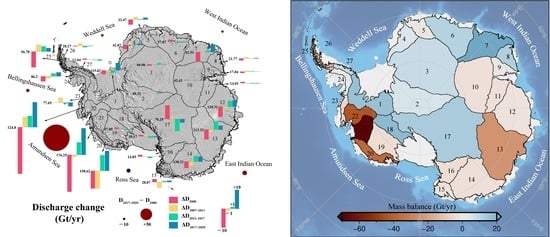Mass Balance of the Antarctic Ice Sheet in the Early 21st Century
Abstract
1. Introduction
2. Data and Methods
2.1. Ice Velocity
2.2. Ice Thickness, Flux Gate, Grounding Line, and Basin Boundary
2.3. Ice Discharge
2.4. Surface Mass Balance
2.5. Mass Balance
2.6. Uncertainty Assessment
3. Results
3.1. Changes in Ice Velocity and Ice Discharge from 2000 to 2020
3.1.1. Amundsen Sea Sector (B20–B22)
3.1.2. Bellingshausen Sea Sector (B23–B25)
3.1.3. Weddell Sea Sector (B26, B27, and B1–B5)
3.1.4. West Indian Ocean Sector (B6–B11)
3.1.5. East Indian Ocean Sector (B12–B14)
3.1.6. Ross Sea Sector (B15–B19)
3.2. SMB Calculation and Changes
3.3. Changes in the Mass Balance
4. Discussion
4.1. Comparison with Other Estimates
4.1.1. Comparison with Gravimetry-Derived Mass Change
4.1.2. Comparison with Altimetry-Derived Mass Change
4.1.3. Comparison with Other IOM-Based Results
4.2. Most Recent Changes
5. Conclusions
Author Contributions
Funding
Data Availability Statement
Acknowledgments
Conflicts of Interest
References
- Fretwell, P.; Pritchard, H.D.; Vaughan, D.G.; Bamber, J.L.; Barrand, N.E.; Bell, R.; Bianchi, C.; Bingham, R.G.; Blankenship, D.D.; Casassa, G.; et al. Bedmap2: Improved Ice Bed, Surface and Thickness Datasets for Antarctica. Cryosphere 2013, 7, 375–393. [Google Scholar] [CrossRef]
- Bamber, J.L.; Westaway, R.M.; Marzeion, B.; Wouters, B. The Land Ice Contribution to Sea Level during the Satellite Era. Environ. Res. Lett. 2018, 13, 063008. [Google Scholar] [CrossRef]
- Morlighem, M.; Rignot, E.; Binder, T.; Blankenship, D.; Drews, R.; Eagles, G.; Eisen, O.; Ferraccioli, F.; Forsberg, R.; Fretwell, P.; et al. Deep Glacial Troughs and Stabilizing Ridges Unveiled beneath the Margins of the Antarctic Ice Sheet. Nat. Geosci. 2020, 13, 132–137. [Google Scholar] [CrossRef]
- The IMBIE team Mass Balance of the Antarctic Ice Sheet from 1992 to 2017. Nature 2018, 558, 219–222. [CrossRef]
- Thomas, E.R.; van Wessem, J.M.; Roberts, J.; Isaksson, E.; Schlosser, E.; Fudge, T.J.; Vallelonga, P.; Medley, B.; Lenaerts, J.; Bertler, N.; et al. Regional Antarctic Snow Accumulation over the Past 1000 Years. Clim. Past 2017, 13, 1491–1513. [Google Scholar] [CrossRef]
- Wadham, J.L.; Hawkings, J.R.; Tarasov, L.; Gregoire, L.J.; Spencer, R.G.M.; Gutjahr, M.; Ridgwell, A.; Kohfeld, K.E. Ice Sheets Matter for the Global Carbon Cycle. Nat. Commun. 2019, 10, 3567. [Google Scholar] [CrossRef]
- Smith, B.; Fricker, H.A.; Gardner, A.S.; Medley, B.; Nilsson, J.; Paolo, F.S.; Holschuh, N.; Adusumilli, S.; Brunt, K.; Csatho, B.; et al. Pervasive Ice Sheet Mass Loss Reflects Competing Ocean and Atmosphere Processes. Science 2020, 368, 1239–1242. [Google Scholar] [CrossRef] [PubMed]
- Rignot, E.; Mouginot, J.; Scheuchl, B.; van den Broeke, M.; van Wessem, M.J.; Morlighem, M. Four Decades of Antarctic Ice Sheet Mass Balance from 1979–2017. Proc. Natl. Acad. Sci. USA 2019, 116, 1095–1103. [Google Scholar] [CrossRef] [PubMed]
- Schröder, L.; Horwath, M.; Dietrich, R.; Helm, V.; van den Broeke, M.R.; Ligtenberg, S.R.M. Four Decades of Antarctic Surface Elevation Changes from Multi-Mission Satellite Altimetry. Cryosphere 2019, 13, 427–449. [Google Scholar] [CrossRef]
- Velicogna, I.; Mohajerani, Y.; Landerer, F.; Mouginot, J.; Noel, B.; Rignot, E.; Sutterley, T.; Broeke, M.; Wessem, M.; Wiese, D. Continuity of Ice Sheet Mass Loss in Greenland and Antarctica From the GRACE and GRACE Follow-On Missions. Geophys. Res. Lett. 2020, 47, e2020GL087291. [Google Scholar] [CrossRef]
- Rignot, E.; Thomas, R.H. Mass Balance of Polar Ice Sheets. Science 2002, 297, 1502–1506. [Google Scholar] [CrossRef]
- Zwally, H.J.; Giovinetto, M.B.; Li, J.; Cornejo, H.G.; Beckley, M.A.; Brenner, A.C.; Saba, J.L.; Yi, D. Mass Changes of the Greenland and Antarctic Ice Sheets and Shelves and Contributions to Sea-Level Rise: 1992–2002. J. Glaciol. 2005, 51, 509–527. [Google Scholar] [CrossRef]
- Tapley, B.D.; Bettadpur, S.; Ries, J.C.; Thompson, P.F.; Watkins, M.M. GRACE Measurements of Mass Variability in the Earth System. Science 2004, 305, 503–505. [Google Scholar] [CrossRef]
- Rignot, E.; Bamber, J.L.; van den Broeke, M.R.; Davis, C.; Li, Y.; van de Berg, W.J.; van Meijgaard, E. Recent Antarctic Ice Mass Loss from Radar Interferometry and Regional Climate Modelling. Nat. Geosci. 2008, 1, 106–110. [Google Scholar] [CrossRef]
- Rignot, E.; Velicogna, I.; van den Broeke, M.R.; Monaghan, A.; Lenaerts, J.T.M. Acceleration of the Contribution of the Greenland and Antarctic Ice Sheets to Sea Level Rise: Acceleration of Ice Sheet Loss. Geophys. Res. Lett. 2011, 38, L05503. [Google Scholar] [CrossRef]
- Gardner, A.S.; Moholdt, G.; Scambos, T.; Fahnstock, M.; Ligtenberg, S.; van den Broeke, M.; Nilsson, J. Increased West Antarctic and Unchanged East Antarctic Ice Discharge over the Last 7 Years. Cryosphere 2018, 12, 521–547. [Google Scholar] [CrossRef]
- Shen, Q.; Wang, H.; Shum, C.K.; Jiang, L.; Hsu, H.T.; Dong, J. Recent High-Resolution Antarctic Ice Velocity Maps Reveal Increased Mass Loss in Wilkes Land, East Antarctica. Sci. Rep. 2018, 8, 4477. [Google Scholar] [CrossRef]
- Li, X.; Rignot, E.; Mouginot, J.; Scheuchl, B. Ice Flow Dynamics and Mass Loss of Totten Glacier, East Antarctica, from 1989 to 2015. Geophys. Res. Lett. 2016, 43, 6366–6373. [Google Scholar] [CrossRef]
- Zhou, C.; Liang, Q.; Chen, Y.; Lei, H.; Fu, Z.; Zheng, L.; Liu, R. Mass Balance Assessment of the Amery Ice Shelf Basin, East Antarctica. Earth Space Sci. 2019, 6, 1987–1999. [Google Scholar] [CrossRef]
- Cui, X.; Du, W.; Xie, H.; Sun, B. The Ice Flux to the Lambert Glacier and Amery Ice Shelf along the Chinese Inland Traverse and Implications for Mass Balance of the Drainage Basins, East Antarctica. Polar Res. 2020, 39, 3582. [Google Scholar] [CrossRef]
- Xu, D.; Tang, X.; Yang, S.; Zhang, Y.; Wang, L.; Li, L.; Sun, B. Revisiting Ice Flux and Mass Balance of the Lambert Glacier–Amery Ice Shelf System Using Multi-Remote-Sensing Datasets, East Antarctica. Remote Sens. 2022, 14, 391. [Google Scholar] [CrossRef]
- Selley, H.L.; Hogg, A.E.; Cornford, S.; Dutrieux, P.; Shepherd, A.; Wuite, J.; Floricioiu, D.; Kusk, A.; Nagler, T.; Gilbert, L.; et al. Widespread Increase in Dynamic Imbalance in the Getz Region of Antarctica from 1994 to 2018. Nat. Commun. 2021, 12, 1133. [Google Scholar] [CrossRef]
- Diener, T.; Sasgen, I.; Agosta, C.; Fürst, J.J.; Braun, M.H.; Konrad, H.; Fettweis, X. Acceleration of Dynamic Ice Loss in Antarctica From Satellite Gravimetry. Front. Earth Sci. 2021, 9, 741789. [Google Scholar] [CrossRef]
- Mouginot, J.; Rignot, E.; Scheuchl, B.; Millan, R. Comprehensive Annual Ice Sheet Velocity Mapping Using Landsat-8, Sentinel-1, and RADARSAT-2 Data. Remote Sens. 2017, 9, 364. [Google Scholar] [CrossRef]
- Gardner, A.S.; Fahnestock, M.A.; Scambos, T.A. MEaSUREs ITS_LIVE Landsat Image-Pair Glacier and Ice Sheet Surface Velocities: Version 1; National Snow and Ice Data Center: Boulder, CO, USA, 2019. [Google Scholar] [CrossRef]
- Scheuchl, B.; Mouginot, J.; Rignot, E. MEaSUREs InSAR-Based Ice Velocity Maps of Central Antarctica: 1997 and 2009, Version 1; NASA National Snow and Ice Data Center Distributed Active Archive Center: Boulder, CO, USA, 2012. [Google Scholar] [CrossRef]
- Rignot, E.; Mouginot, J.; Scheuchl, B. MEaSUREs InSAR-Based Antarctica Ice Velocity Map, Version 2. [Indicate Subset Used]; NASA National Snow and Ice Data Center Distributed Active Archive Center: Boulder, CO, USA, 2017. [Google Scholar] [CrossRef]
- Rignot, E.; Mouginot, J.; Scheuchl, B.; Jeong, S. Changes in Antarctic Ice Sheet Motion Derived From Satellite Radar Interferometry Between 1995 and 2022. Geophys. Res. Lett. 2022, 49, e2022GL100141. [Google Scholar] [CrossRef]
- Zwally, H.J.; Giovinetto, M.B.; Beckley, M.A.; Saba, J.L. Antarctic and Greenland Drainage Systems. GSFC Cryospheric Sciences Laboratory. 2012. Available online: http://icesat4.gsfc.nasa.gov/cryo_data/ant_grn_drainage_systems.php (accessed on 30 May 2022).
- Depoorter, M.A.; Bamber, J.L.; Griggs, J.A.; Lenaerts, J.T.M.; Ligtenberg, S.R.M.; van den Broeke, M.R.; Moholdt, G. Calving Fluxes and Basal Melt Rates of Antarctic Ice Shelves. Nature 2013, 502, 89–92. [Google Scholar] [CrossRef]
- Griggs, J.A.; Bamber, J.L. Antarctic Ice-Shelf Thickness from Satellite Radar Altimetry. J. Glaciol. 2011, 57, 485–498. [Google Scholar] [CrossRef]
- Morlighem, M.; Rignot, E.; Seroussi, H.; Larour, E.; Ben Dhia, H.; Aubry, D. A Mass Conservation Approach for Mapping Glacier Ice Thickness: BALANCE THICKNESS. Geophys. Res. Lett. 2011, 38. [Google Scholar] [CrossRef]
- Agosta, C.; Amory, C.; Kittel, C.; Orsi, A.; Favier, V.; Gallée, H.; van den Broeke, M.R.; Lenaerts, J.T.M.; van Wessem, J.M.; van de Berg, W.J.; et al. Estimation of the Antarctic Surface Mass Balance Using the Regional Climate Model MAR (1979–2015) and Identification of Dominant Processes. Cryosphere 2019, 13, 281–296. [Google Scholar] [CrossRef]
- Gossart, A.; Helsen, S.; Lenaerts, J.T.M.; Broucke, S.V.; van Lipzig, N.P.M.; Souverijns, N. An Evaluation of Surface Climatology in State-of-the-Art Reanalyses over the Antarctic Ice Sheet. J. Clim. 2019, 32, 6899–6915. [Google Scholar] [CrossRef]
- Wessem, J.M.V.; van de Berg, W.J.; Noël, B.P.Y.; van Meijgaard, E.; Amory, C.; Birnbaum, G.; Jakobs, C.L.; Krüger, K.; Lenaerts, J.T.M.; Lhermitte, S.; et al. Modelling the Climate and Surface Mass Balance of Polar Ice Sheets Using RACMO2—Part 2: Antarctica (1979–2016). Cryosphere 2018, 12, 1479–1498. [Google Scholar] [CrossRef]
- Lenaerts, J.T.M.; Medley, B.; van den Broeke, M.R.; Wouters, B. Observing and Modeling Ice Sheet Surface Mass Balance. Rev. Geophys. 2019, 57, 376–420. [Google Scholar] [CrossRef]
- Wessem, J.M.V.; Reijmer, C.H.; Morlighem, M.; Mouginot, J.; Rignot, E.; Medley, B.; Joughin, I.; Wouters, B.; Depoorter, M.A.; Bamber, J.L.; et al. Improved Representation of East Antarctic Surface Mass Balance in a Regional Atmospheric Climate Model. J. Glaciol. 2014, 60, 761–770. [Google Scholar] [CrossRef]
- Mohajerani, Y.; Velicogna, I.; Rignot, E. Mass Loss of Totten and Moscow University Glaciers, East Antarctica, Using Regionally Optimized GRACE Mascons. Geophys. Res. Lett. 2018, 45, 7010–7018. [Google Scholar] [CrossRef]
- Mohajerani, Y.; Velicogna, I.; Rignot, E. Evaluation of Regional Climate Models Using Regionally Optimized GRACE Mascons in the Amery and Getz Ice Shelves Basins, Antarctica. Geophys. Res. Lett. 2019, 46, 13883–13891. [Google Scholar] [CrossRef]
- Muñoz-Sabater, J.; Dutra, E.; Agustí-Panareda, A.; Albergel, C.; Arduini, G.; Balsamo, G.; Boussetta, S.; Choulga, M.; Harrigan, S.; Hersbach, H.; et al. ERA5-Land: A State-of-the-Art Global Reanalysis Dataset for Land Applications. Earth Syst. Sci. Data 2021, 13, 4349–4383. [Google Scholar] [CrossRef]
- Haran, T.; Klinger, M.; Bohlander, J.; Fahnestock, M.; Painter, T.; Scambos, T. MEaSUREs MODIS Mosaic of Antarctica 2013–2014 (MOA2014) Image Map, Version 1. [Surface Morphology]; NASA National Snow and Ice Data Center Distributed Active Archive Center: Boulder, CO, USA, 2018. [Google Scholar] [CrossRef]
- Cheng, Y.; Xia, M.; Qiao, G.; Lv, D.; Li, Y.; Hai, G. Imminent Calving Accelerated by Increased Instability of the Brunt Ice Shelf, in Response to Climate Warming. Earth Planet. Sci. Lett. 2021, 572, 117132. [Google Scholar] [CrossRef]
- Mottram, R.; Hansen, N.; Kittel, C.; van Wessem, J.M.; Agosta, C.; Amory, C.; Boberg, F.; van de Berg, W.J.; Fettweis, X.; Gossart, A.; et al. What Is the Surface Mass Balance of Antarctica? An Intercomparison of Regional Climate Model Estimates. Cryosphere 2021, 15, 3751–3784. [Google Scholar] [CrossRef]
- Conway, H.; Rasmussen, L.A. Recent Thinning and Migration of the Western Divide, Central West Antarctica. Geophys. Res. Lett. 2009, 36, L12502. [Google Scholar] [CrossRef]
- Deb, P.; Orr, A.; Bromwich, D.H.; Nicolas, J.P.; Turner, J.; Hosking, J.S. Summer Drivers of Atmospheric Variability Affecting Ice Shelf Thinning in the Amundsen Sea Embayment, West Antarctica. Geophys. Res. Lett. 2018, 45, 4124–4133. [Google Scholar] [CrossRef]
- Kang, J.; Lu, Y.; Li, Y.; Zhang, Z.; Shi, H. Antarctic Basal Water Storage Variation Inferred from Multi-Source Satellite Observation and Relevant Models. Remote Sens. 2022, 14, 2337. [Google Scholar] [CrossRef]
- Artemieva, I.M. Antarctica Ice Sheet Basal Melting Enhanced by High Mantle Heat. Earth-Sci. Rev. 2022, 226, 103954. [Google Scholar] [CrossRef]
- Miles, B.W.J.; Stokes, C.R.; Jamieson, S.S.R.; Jordan, J.R.; Gudmundsson, G.H.; Jenkins, A. High Spatial and Temporal Variability in Antarctic Ice Discharge Linked to Ice Shelf Buttressing and Bed Geometry. Sci. Rep. 2022, 12, 10968. [Google Scholar] [CrossRef] [PubMed]
- Cheng, Y.; Xia, M.; Qiao, G.; Li, Y.; Hai, G.; Lv, D. Calving Cycle of Ninnis Glacier over the Last 60 Years. Int. J. Appl. Earth Obs. Geoinf. 2021, 105, 102612. [Google Scholar] [CrossRef]
- Thoma, M.; Jenkins, A.; Holland, D.; Jacobs, S. Modelling Circumpolar Deep Water Intrusions on the Amundsen Sea Continental Shelf, Antarctica. Geophys. Res. Lett. 2008, 35, L18602. [Google Scholar] [CrossRef]
- Jacobs, S.S.; Jenkins, A.; Giulivi, C.F.; Dutrieux, P. Stronger Ocean Circulation and Increased Melting under Pine Island Glacier Ice Shelf. Nat. Geosci. 2011, 4, 519–523. [Google Scholar] [CrossRef]
- MacGregor, J.A.; Catania, G.A.; Markowski, M.S.; Andrews, A.G. Widespread Rifting and Retreat of Ice-Shelf Margins in the Eastern Amundsen Sea Embayment between 1972 and 2011. J. Glaciol. 2012, 58, 458–466. [Google Scholar] [CrossRef]
- Scott, R.C.; Nicolas, J.P.; Bromwich, D.H.; Norris, J.R.; Lubin, D. Meteorological Drivers and Large-Scale Climate Forcing of West Antarctic Surface Melt. J. Clim. 2019, 32, 665–684. [Google Scholar] [CrossRef]
- Bodart, J.A.; Bingham, R.J. The Impact of the Extreme 2015–2016 El Niño on the Mass Balance of the Antarctic Ice Sheet. Geophys. Res. Lett. 2019, 46, 13862–13871. [Google Scholar] [CrossRef]
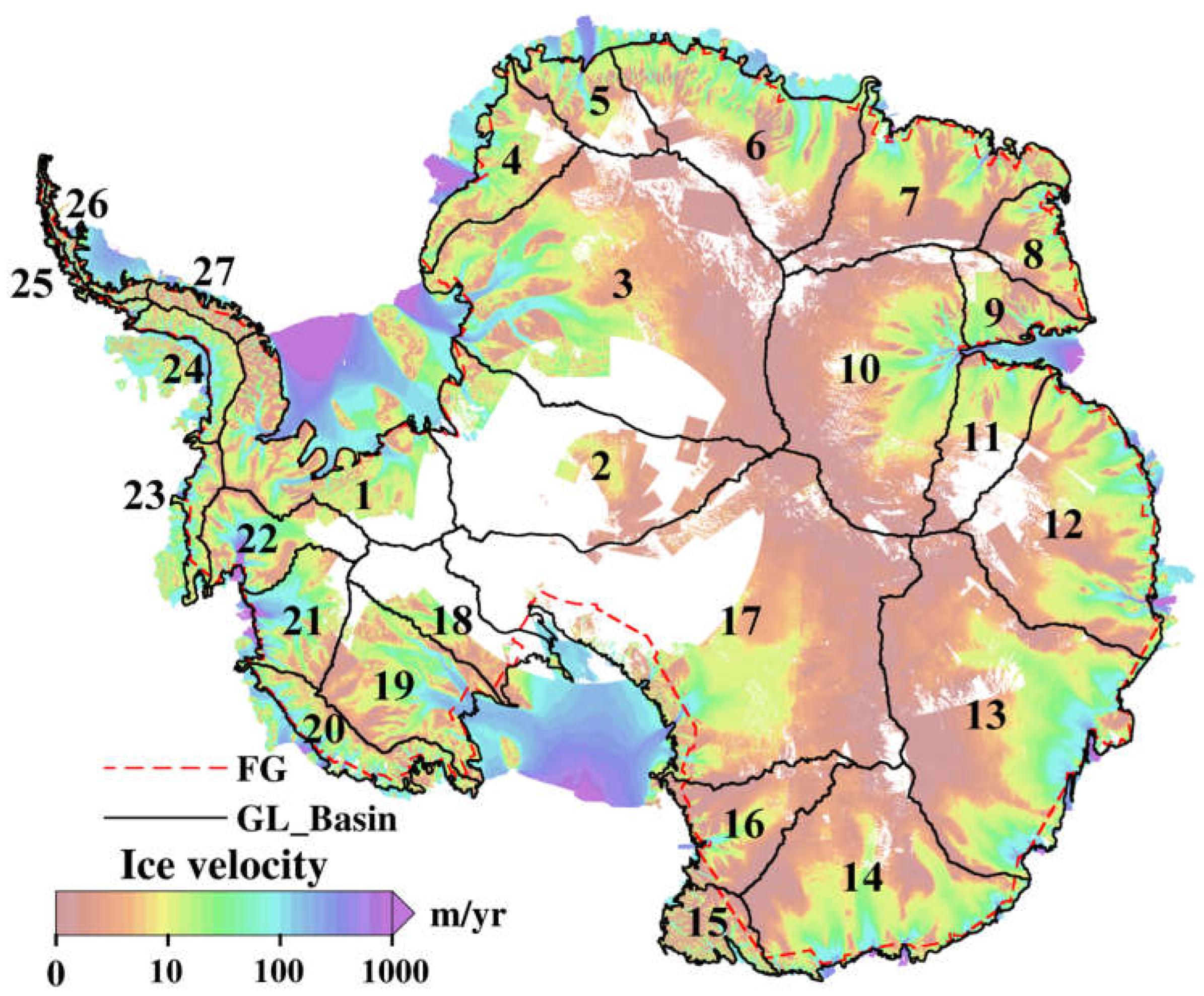
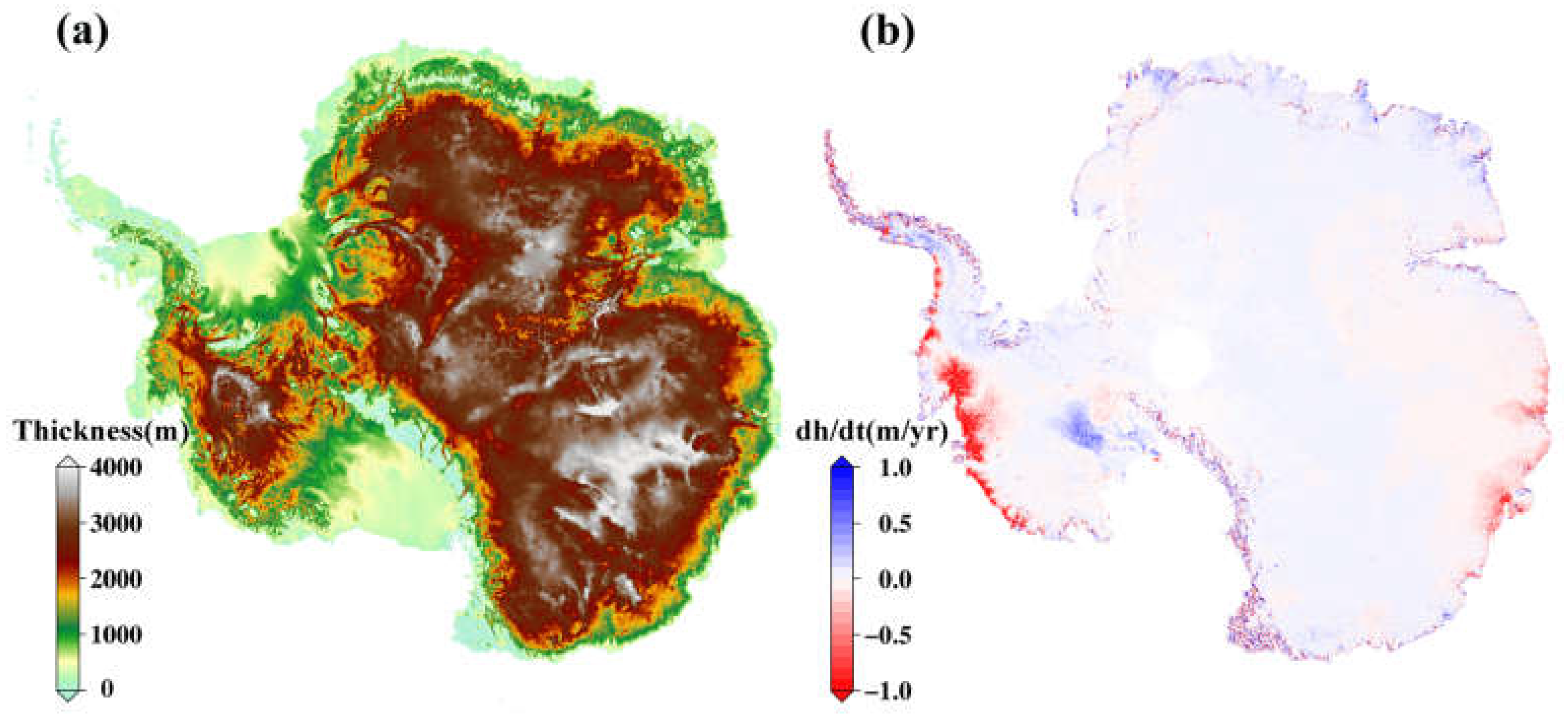
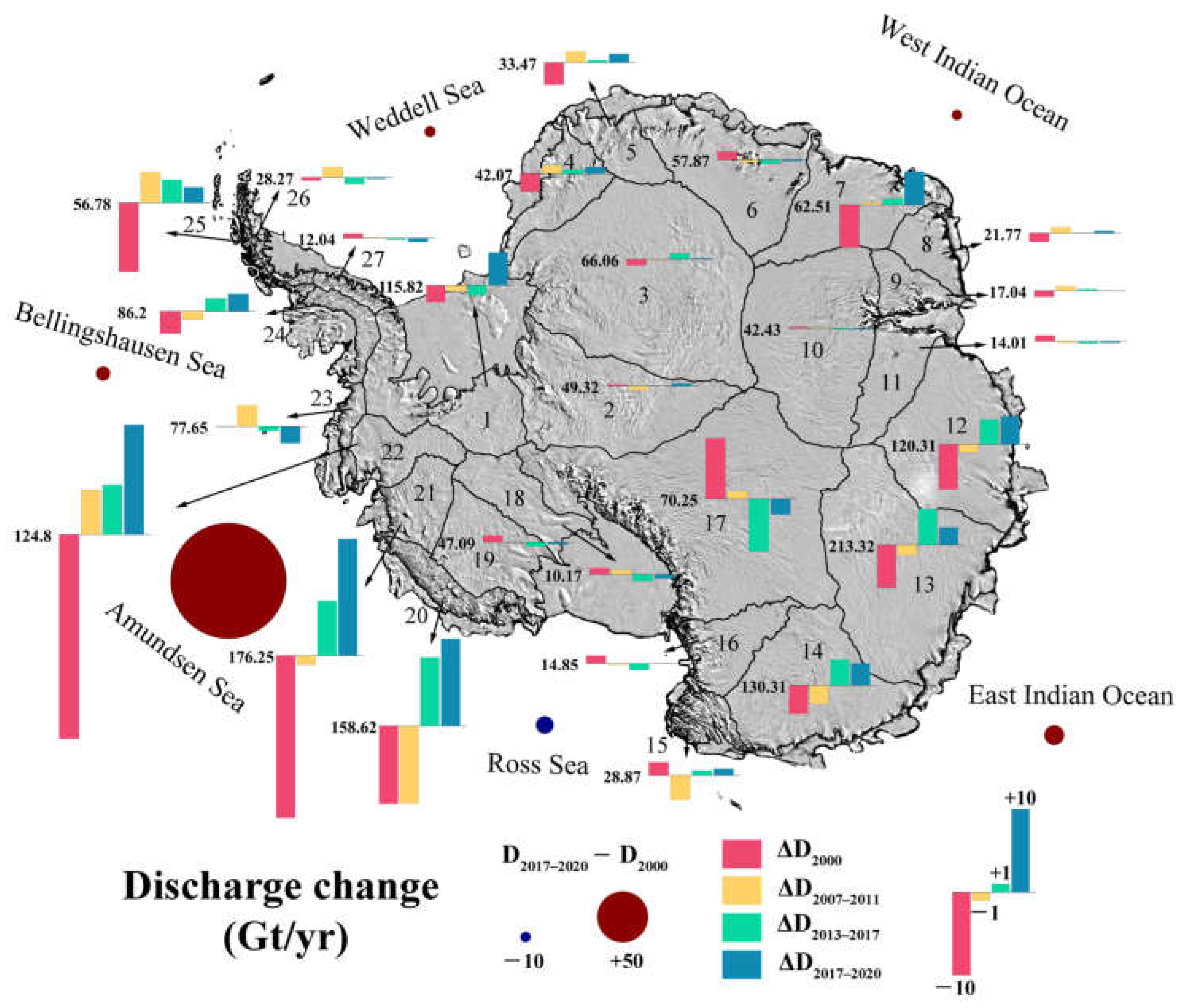



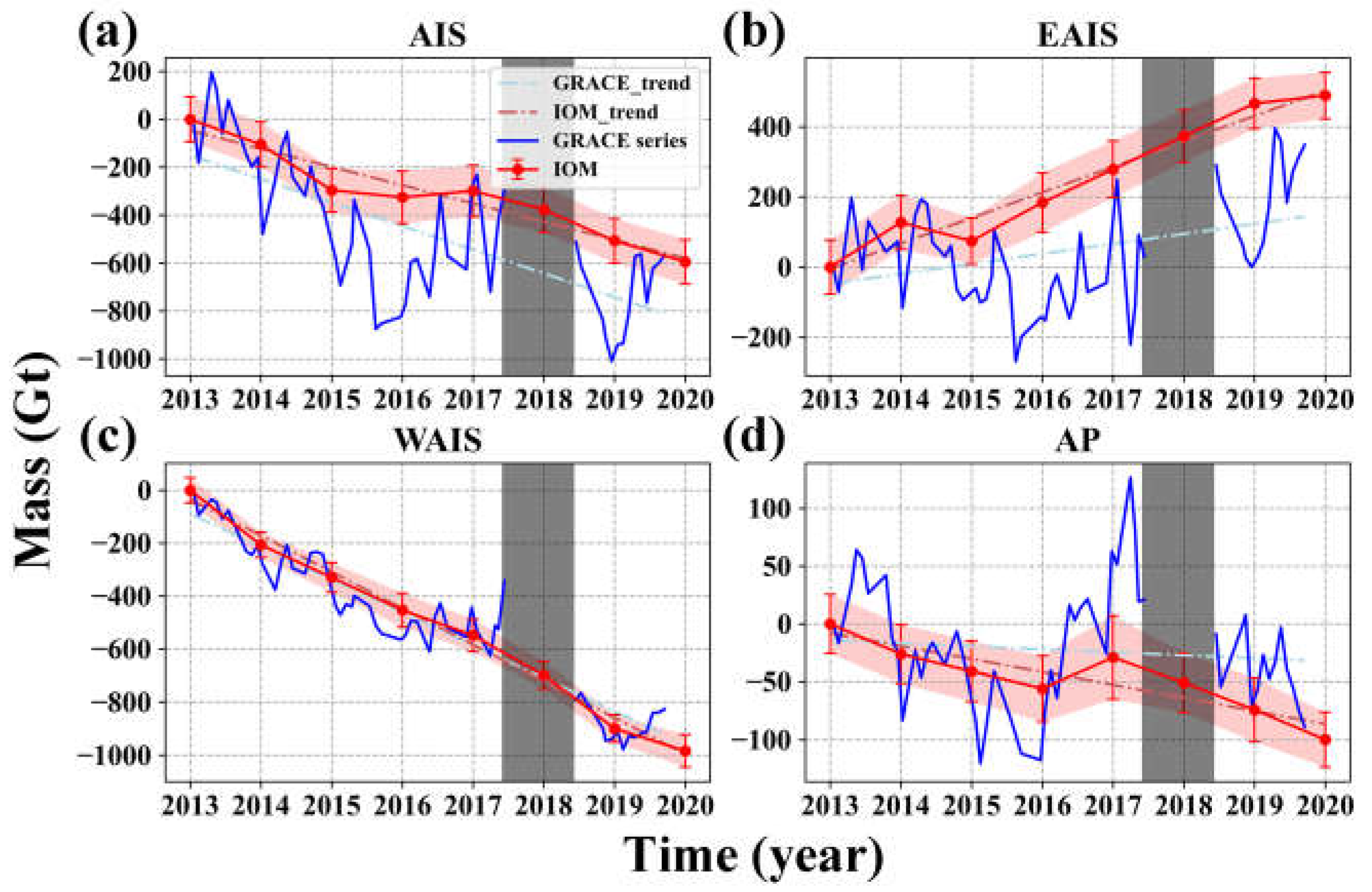
| Epoch | MEaSUREs Annual Velocity Products [24] | Fill Missing Values Products | ||
|---|---|---|---|---|
| Central [26] | ITS_LIVE [16] | Phase [27] | ||
| 2000 | 2000–2001 | ✓ | 2000 | ✓ |
| 2007–2011 | 2007–2008, 2008–2009, 2010–2011 | ✓ | 2007, 2008, 2010 | ✓ |
| 2013–2017 | 2013–2014, 2014–2015 2015–2016, 2016–2017 | ✓ | / | / |
| 2017–2020 | 2017–2018, 2018–2019, 2019–2020 | ✓ | / | / |
| Basin | Area (km2) | Discharge (Gt/yr) | Mean of SMB (Gt/yr) | |||
|---|---|---|---|---|---|---|
| 2000 | 2007–2011 | 2013–2017 | 2017–2020 | |||
| 1 | 479,840 | 114 ± 25 | 115 ± 20 | 115 ± 20 | 120 ± 7 | 133 ± 27 |
| 2 | 780,488 | 50 ± 3 | 49 ± 8 | 49 ± 4 | 50 ± 4 | 55 ± 11 |
| 3 | 1,570,432 | 65 ± 8 | 66 ± 5 | 67 ± 4 | 66 ± 2 | 75 ± 15 |
| 4 | 244,696 | 40 ± 8 | 43 ± 9 | 43 ± 10 | 43 ± 5 | 48 ± 10 |
| 5 | 186,884 | 31 ± 4 | 35 ± 5 | 34 ± 7 | 35 ± 3 | 35 ± 7 |
| 6 | 606,040 | 59 ± 8 | 58 ± 12 | 57 ± 13 | 58 ± 6 | 70 ± 14 |
| 7 | 493,857 | 57 ± 9 | 63 ± 12 | 63 ± 11 | 67 ± 8 | 88 ± 18 |
| 8 | 159,829 | 21 ± 5 | 23 ± 8 | 22 ± 5 | 22 ± 3 | 35 ± 7 |
| 9 | 145,674 | 16 ± 4 | 18 ± 6 | 17 ± 3 | 17 ± 2 | 18 ± 4 |
| 10 | 919,362 | 43 ± 2 | 43 ± 2 | 42 ± 2 | 42 ± 1 | 40 ± 8 |
| 11 | 257,477 | 15 ± 3 | 14 ± 6 | 14 ± 3 | 14 ± 1 | 15 ± 3 |
| 12 | 719,472 | 114 ± 14 | 119 ± 18 | 124 ± 15 | 124 ± 11 | 121 ± 24 |
| 13 | 1,109,722 | 208 ± 14 | 212 ± 18 | 218 ± 19 | 216 ± 16 | 191 ± 38 |
| 14 | 711,661 | 127 ± 11 | 128 ± 16 | 134 ± 15 | 133 ± 14 | 129 ± 26 |
| 15 | 124,081 | 31 ± 7 | 26 ± 7 | 30 ± 6 | 30 ± 6 | 28 ± 6 |
| 16 | 265,501 | 16 ± 3 | 15 ± 3 | 14 ± 2 | 15 ± 1 | 12 ± 2 |
| 17 | 1,843,824 | 78 ± 11 | 71 ± 14 | 63 ± 13 | 68 ± 9 | 82 ± 16 |
| 18 | 266,471 | 11 ± 1 | 11 ± 2 | 9 ± 2 | 10 ± 1 | 29 ± 6 |
| 19 | 372,696 | 48 ± 4 | 47 ± 6 | 47 ± 4 | 47 ± 3 | 44 ± 9 |
| 20 | 182,833 | 148 ± 15 | 148 ± 10 | 168 ± 17 | 170 ± 15 | 124 ± 25 |
| 21 | 210,994 | 155 ± 10 | 175 ± 10 | 183 ± 11 | 192 ± 11 | 106 ± 21 |
| 22 | 213,744 | 98 ± 4 | 131 ± 3 | 131 ± 4 | 139 ± 3 | 87 ± 17 |
| 23 | 75,159 | 78 ± 8 | 80 ± 6 | 77 ± 10 | 75 ± 8 | 73 ± 15 |
| 24 | 100,865 | 83 ± 8 | 85 ± 5 | 88 ± 7 | 88 ± 6 | 90 ± 18 |
| 25 | 34,212 | 48 ± 7 | 61 ± 8 | 60 ± 9 | 59 ± 8 | 71 ± 14 |
| 26 | 41,519 | 28 ± 4 | 30 ± 3 | 27 ± 4 | 28 ± 3 | 44 ± 9 |
| 27 | 52,136 | 13 ± 3 | 12 ± 1 | 12 ± 2 | 12 ± 1 | 21 ± 4 |
| EAIS | 10,139,000 | 968 ± 32 | 980 ± 26 | 991 ± 31 | 1000 ± 22 | 1042 ± 64 |
| WAIS | 1,801,737 | 652 ± 32 | 707 ± 42 | 730 ± 39 | 753 ± 29 | 596 ± 49 |
| AP | 228,732 | 172 ± 12 | 188 ± 10 | 187 ± 12 | 187 ± 10 | 226 ± 25 |
| Total | 12,169,469 | 1792 ± 47 | 1876 ± 51 | 1908 ± 51 | 1940 ± 37 | 1864 ± 85 |
| Basin | Mass Balance (Gt/yr) | ||||
|---|---|---|---|---|---|
| 2000 | 2007–2011 | 2013–2017 | 2017–2020 | Mean | |
| 1 | 13 ± 36 | 15 ± 33 | 21 ± 34 | 14 ± 28 | 17 ± 32 |
| 2 | 3 ± 11 | 4 ± 13 | 7 ± 12 | 8 ± 12 | 6 ± 12 |
| 3 | 11 ± 17 | 6 ± 15 | 10 ± 16 | 11 ± 16 | 9 ± 16 |
| 4 | 1 ± 11 | 5 ± 13 | 4 ± 14 | 9 ± 12 | 5 ± 13 |
| 5 | −1 ± 7 | −3 ± 8 | 4 ± 10 | 3 ± 8 | 1 ± 9 |
| 6 | 13 ± 17 | 3 ± 17 | 18 ± 20 | 13 ± 15 | 12 ± 18 |
| 7 | 20 ± 18 | 20 ± 21 | 23 ± 21 | 31 ± 21 | 24 ± 21 |
| 8 | 9 ± 8 | 11 ± 10 | 13 ± 9 | 16 ± 9 | 13 ± 9 |
| 9 | −3 ± 4 | 0 ± 7 | 0 ± 5 | 2 ± 4 | 1 ± 6 |
| 10 | −7 ± 7 | 0 ± 9 | −5 ± 8 | −2 ± 8 | −2 ± 8 |
| 11 | −1 ± 4 | 1 ± 6 | 1 ± 5 | 1 ± 3 | 1 ± 5 |
| 12 | 3 ± 28 | 14 ± 32 | −6 ± 29 | −12 ± 25 | −1 ± 28 |
| 13 | 12 ± 46 | −27 ± 41 | −18 ± 44 | −40 ± 39 | −24 ± 42 |
| 14 | −14 ± 25 | −20 ± 27 | 10 ± 32 | 5 ± 31 | −2 ± 30 |
| 15 | 0 ± 9 | −2 ± 8 | 0 ± 9 | −1 ± 8 | −1 ± 8 |
| 16 | −2 ± 4 | −4 ± 4 | −4 ± 3 | 0 ± 3 | −3 ± 3 |
| 17 | 12 ± 21 | 5 ± 21 | 13 ± 20 | 25 ± 21 | 14 ± 20 |
| 18 | 17 ± 6 | 15 ± 6 | 21 ± 7 | 21 ± 6 | 19 ± 6 |
| 19 | −5 ± 9 | −7 ± 10 | −1 ± 10 | −1 ± 10 | −3 ± 10 |
| 20 | −13 ± 31 | −37 ± 26 | −44 ± 30 | −38 ± 30 | −37 ± 29 |
| 21 | −28 ± 27 | −74 ± 23 | −82 ± 23 | −81 ± 25 | −75 ± 24 |
| 22 | 4 ± 21 | −45 ± 17 | −46 ± 18 | −53 ± 18 | −43 ± 17 |
| 23 | 3 ± 18 | −2 ± 17 | −7 ± 17 | −7 ± 16 | −5 ± 17 |
| 24 | 3 ± 19 | 4 ± 19 | 9 ± 21 | −7 ± 17 | 3 ± 19 |
| 25 * | −10 ± 13 | −10 ± 13 | −10 ± 13 | −10 ± 13 | −10 ± 13 |
| 26 * | −16 ± 10 | −16 ± 10 | −16 ± 10 | −16 ± 10 | −16 ± 10 |
| 27 | 8 ± 5 | 7 ± 4 | 10 ± 5 | 9 ± 4 | 9 ± 4 |
| EAIS | 56 ± 62 | 13 ± 55 | 70 ± 58 | 70 ± 55 | 53 ± 56 |
| WAIS | −9 ± 73 | −135 ± 75 | −137 ± 77 | −145 ± 71 | −127 ± 74 |
| AP | −15 ± 25 | −15 ± 28 | −7 ± 29 | −24 ± 26 | −15 ± 32 |
| AIS | 33 ± 99 | −137 ± 97 | −75 ± 101 | −99 ± 93 | −89 ± 99 |
| Method | Region | Span (Years) | Mean of Mass Balance (Gt/yr) | Uncertanity (Gt/yr) |
|---|---|---|---|---|
| IOM | EAIS | 2013–2020 | 70 | 66 |
| WAIS | 2013–2020 | −141 | 61 | |
| AP | 2013–2020 | −14 | 24 | |
| AIS | 2013–2020 | −85 | 93 | |
| Gravimetry | EAIS | 2013–2020 | 50 | / |
| WAIS | 2013–2020 | −118 | / | |
| AP | 2013–2020 | −13 | / | |
| AIS | 2013–2020 | −81 | / | |
| Altimetry * | EAIS | 2003–2019 | 90 | 21 |
| WAIS | 2003–2019 | −169 | 10 | |
| AP | 2003–2019 | −39 | 5 | |
| AIS | 2003–2019 | −118 | 24 |
Disclaimer/Publisher’s Note: The statements, opinions and data contained in all publications are solely those of the individual author(s) and contributor(s) and not of MDPI and/or the editor(s). MDPI and/or the editor(s) disclaim responsibility for any injury to people or property resulting from any ideas, methods, instructions or products referred to in the content. |
© 2023 by the authors. Licensee MDPI, Basel, Switzerland. This article is an open access article distributed under the terms and conditions of the Creative Commons Attribution (CC BY) license (https://creativecommons.org/licenses/by/4.0/).
Share and Cite
Yang, T.; Liang, Q.; Zheng, L.; Li, T.; Chen, Z.; Hui, F.; Cheng, X. Mass Balance of the Antarctic Ice Sheet in the Early 21st Century. Remote Sens. 2023, 15, 1677. https://doi.org/10.3390/rs15061677
Yang T, Liang Q, Zheng L, Li T, Chen Z, Hui F, Cheng X. Mass Balance of the Antarctic Ice Sheet in the Early 21st Century. Remote Sensing. 2023; 15(6):1677. https://doi.org/10.3390/rs15061677
Chicago/Turabian StyleYang, Tian, Qi Liang, Lei Zheng, Teng Li, Zhuoqi Chen, Fengming Hui, and Xiao Cheng. 2023. "Mass Balance of the Antarctic Ice Sheet in the Early 21st Century" Remote Sensing 15, no. 6: 1677. https://doi.org/10.3390/rs15061677
APA StyleYang, T., Liang, Q., Zheng, L., Li, T., Chen, Z., Hui, F., & Cheng, X. (2023). Mass Balance of the Antarctic Ice Sheet in the Early 21st Century. Remote Sensing, 15(6), 1677. https://doi.org/10.3390/rs15061677






